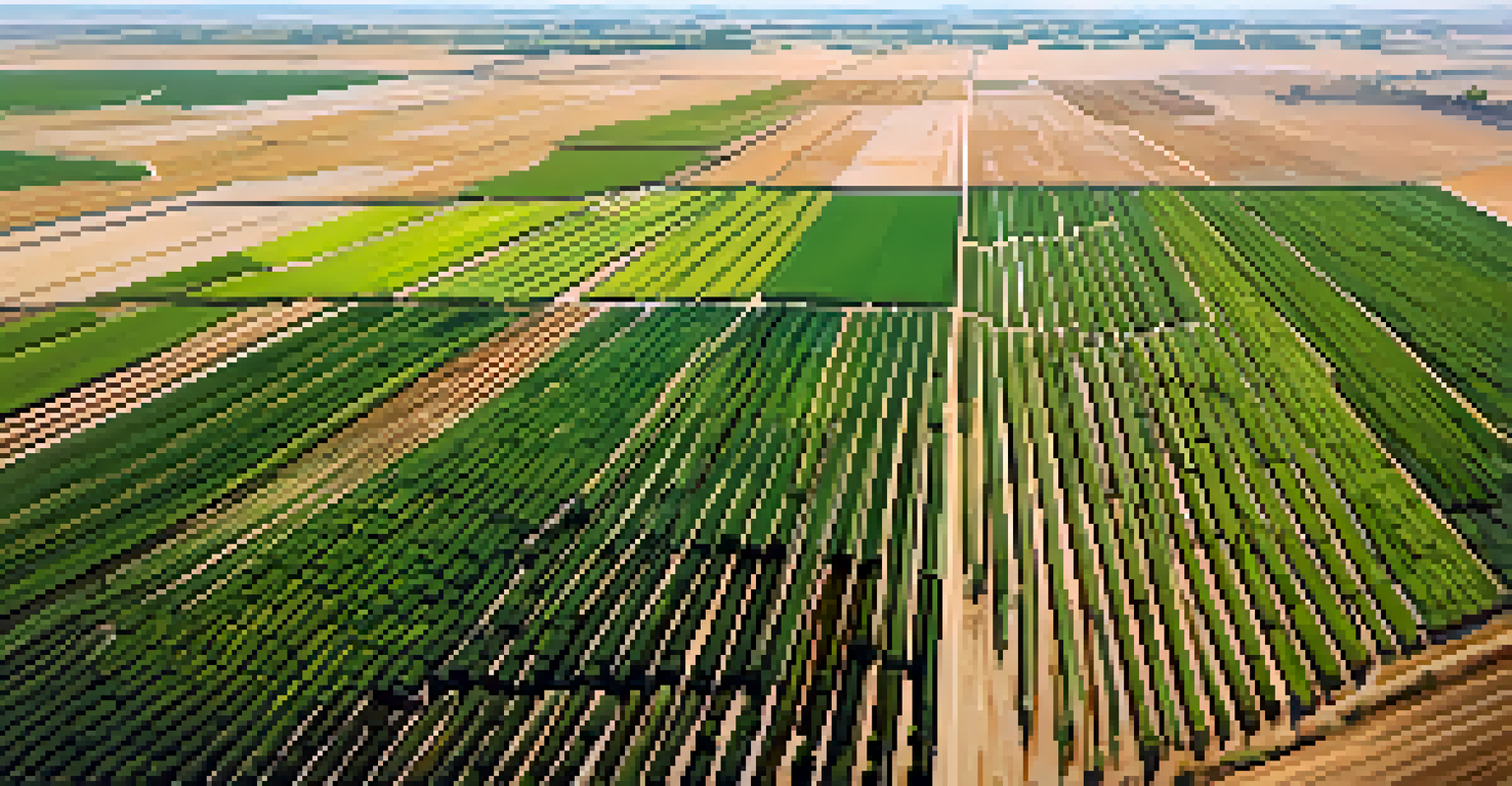Impact of Climate Change on Sacramento's Water Resources

Overview of Sacramento's Water Resources
Sacramento, the capital of California, relies heavily on its water resources, primarily sourced from rivers and reservoirs. The Sacramento River, along with its tributaries, plays a significant role in supplying water for drinking, agriculture, and recreation. However, understanding the complexities of these resources is critical as we face an evolving climate. As temperatures rise and weather patterns change, the region's water availability is increasingly at risk.
Water is the driving force of all nature.
The city has a rich history of managing its water supply, but climate change introduces new challenges. For instance, fluctuating precipitation patterns can lead to either droughts or floods, both of which can severely disrupt the water supply chain. Local agriculture, which thrives on predictable water access, may find itself struggling to adapt to these changes. As such, Sacramento's water management strategies must evolve to ensure sustainability.
Moreover, the interconnectedness of local ecosystems and water resources means that any impact on one area can have a ripple effect throughout the region. For example, reduced snowpack in the Sierra Nevada mountains, which feeds into the Sacramento River, could lead to water shortages. Thus, a comprehensive understanding of Sacramento's water resources is essential to mitigating the impacts of climate change.
How Climate Change Affects Precipitation Patterns
One of the most significant impacts of climate change on Sacramento's water resources is the alteration of precipitation patterns. Traditionally, the region experiences a Mediterranean climate, characterized by wet winters and dry summers. However, climate change is leading to increased variability in these patterns, with some years witnessing excessive rainfall while others experience severe droughts.

This inconsistency poses challenges for water management, as reservoirs may not fill adequately during wet seasons to prepare for dry periods. For instance, during unusually dry years, farmers may struggle to irrigate their crops, leading to reduced agricultural output. Conversely, heavy rainfall can overwhelm drainage systems, causing flooding and potential damage to infrastructure.
Climate Change Alters Water Patterns
Shifts in precipitation due to climate change create challenges for water management in Sacramento, leading to both droughts and floods.
As a result, local authorities are tasked with the monumental challenge of forecasting and managing these changing precipitation patterns. Investing in updated forecasting technology and infrastructure improvements will be crucial in adapting to these shifts. By doing so, Sacramento can better prepare for the unpredictable nature of climate change.
The Role of Snowpack in Water Supply
Snowpack, which acts as a natural reservoir, is another critical factor in Sacramento's water resources. During winter months, snow accumulates in the Sierra Nevada mountains, gradually melting and providing vital water flow during the warmer months. However, rising temperatures are causing earlier snowmelt, which can disrupt this timing and lead to water shortages during peak summer demands.
We do not inherit the earth from our ancestors; we borrow it from our children.
For example, if the snowpack melts too early due to warmer temperatures, the water may flow into rivers when it is not needed, leaving reservoirs low during the dry months. This mismatch can have devastating effects on local agriculture, which relies heavily on consistent water supply throughout the growing season. Farmers may face tough decisions, including fallowing land or switching to more drought-resistant crops.
To address these challenges, the region must adopt flexible water management practices that can adapt to changing snowpack conditions. This may include developing more robust storage solutions and diversifying water sources to ensure that agriculture and residents have access to reliable water supply year-round.
Heat Waves and Their Impact on Water Demand
As climate change leads to more frequent and intense heat waves, the demand for water in Sacramento is also increasing. Hotter temperatures drive up the need for irrigation in agricultural practices, as crops require more water to survive and thrive. Additionally, urban areas experience heightened water consumption as residents turn to irrigation systems to maintain their lawns and gardens.
This increased demand can put a significant strain on already limited water resources. During peak summer months, water supply systems may struggle to keep up with the surge in usage, leading to potential shortages. Local water authorities may need to implement conservation measures or restrictions to manage this heightened demand effectively.
Snowpack's Role in Water Supply
Rising temperatures cause earlier snowmelt in the Sierra Nevada, disrupting the timing of water availability during peak demand seasons.
Moreover, addressing the impact of heat waves on water demand also requires community engagement. Educating residents about efficient water usage and promoting drought-tolerant landscaping can help mitigate this pressure. By fostering a culture of conservation, Sacramento can work towards a more sustainable water future amidst rising temperatures.
Flooding Risks Due to Climate Change
While droughts often capture headlines, climate change also brings about increased flooding risks in Sacramento. As precipitation patterns become more erratic, heavy rainfall events can lead to rapid runoff and overwhelm the existing drainage systems. This can result in localized flooding, damaging homes, businesses, and infrastructure.
Furthermore, rising sea levels can exacerbate flooding risks, particularly in low-lying areas. The Sacramento-San Joaquin Delta, a crucial water supply hub, is particularly vulnerable to these changes. If floodwaters breach levees, it could compromise the quality and availability of drinking water for the entire region.
To combat these flooding risks, Sacramento must invest in resilient infrastructure and comprehensive flood management strategies. This may include upgrading levees, creating green spaces to absorb excess water, and improving drainage systems. By proactively addressing these challenges, the city can better protect its residents and resources from the impacts of climate change.
Water Quality Challenges Amidst Climate Change
Climate change doesn't just affect water quantity; it also poses significant challenges to water quality in Sacramento. Increased temperatures can lead to harmful algal blooms in rivers and reservoirs, which can produce toxins harmful to both humans and wildlife. This can complicate water treatment processes and potentially threaten public health.
Additionally, extreme weather events can lead to increased runoff, carrying pollutants into local water bodies. When heavy rains wash fertilizers, pesticides, and other contaminants into rivers, the quality of drinking water can be compromised. This highlights the need for improved water quality monitoring and management strategies to safeguard public health.
Community Engagement is Crucial
Involving residents in water conservation efforts can significantly enhance Sacramento's resilience against climate change challenges.
To tackle these water quality challenges, Sacramento needs to prioritize sustainable land-use practices and enhance pollution control measures. By promoting environmentally friendly agricultural practices and monitoring water quality more rigorously, the city can work towards ensuring safe and clean water for its residents.
Community Engagement in Water Conservation Efforts
As Sacramento faces the challenges posed by climate change, community engagement becomes increasingly vital in promoting water conservation. Residents can play a crucial role in preserving this precious resource by adopting water-saving practices in their daily lives. Simple actions, such as fixing leaks, using efficient irrigation systems, and opting for drought-resistant plants, can make a significant difference.
Local authorities can support these efforts by providing education and resources to the community. Workshops, informational campaigns, and incentive programs can encourage residents to actively participate in conservation efforts. Furthermore, involving community members in decision-making processes related to water management can foster a sense of ownership and responsibility.

Ultimately, a collective approach to water conservation will be essential for Sacramento's resilience against climate change. By working together, residents and authorities can ensure that the region's water resources are preserved for future generations, contributing to a sustainable and thriving community.